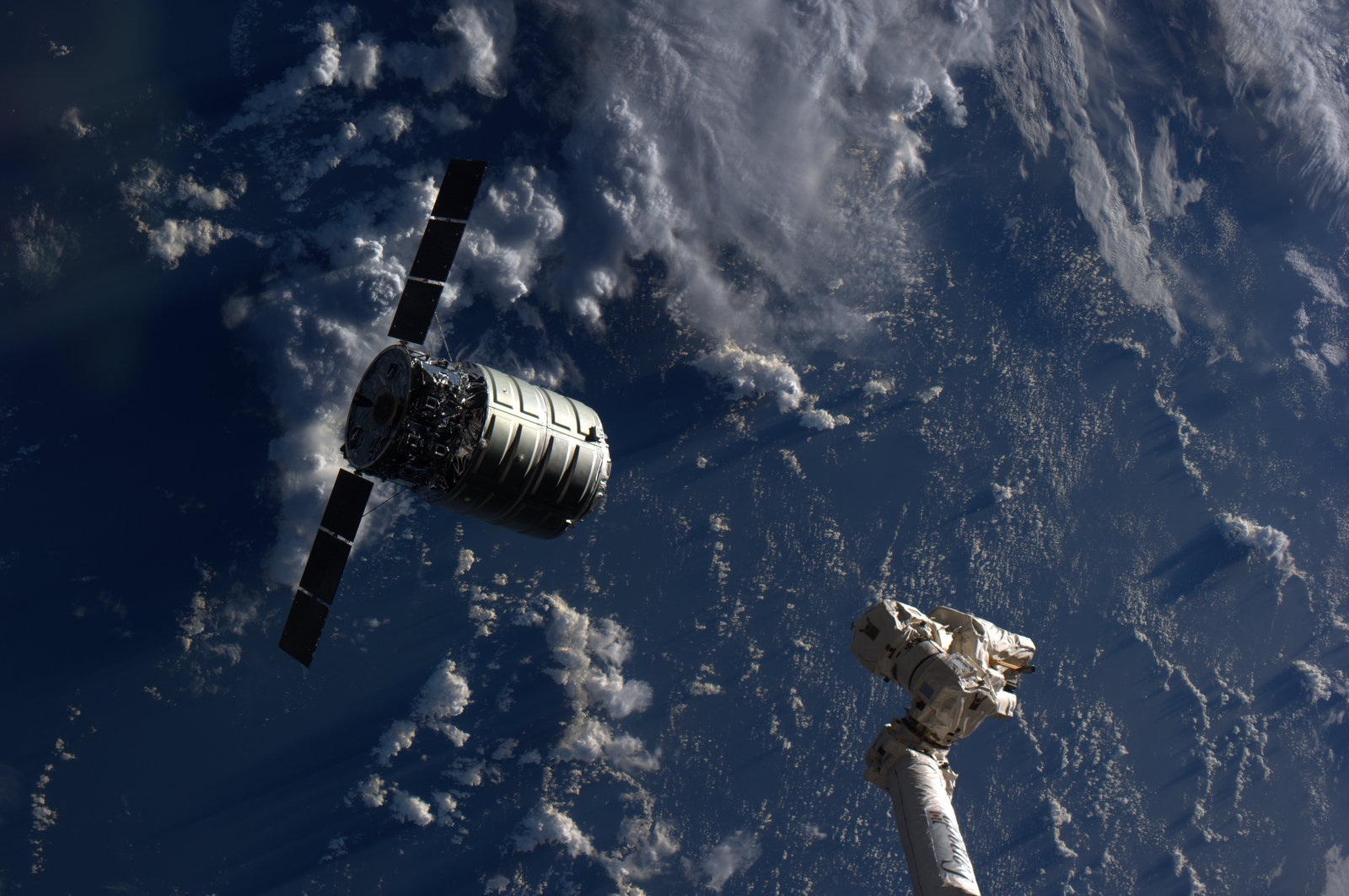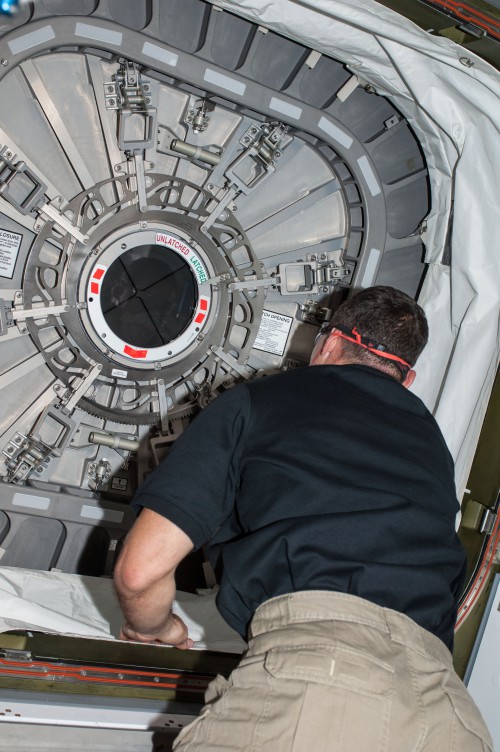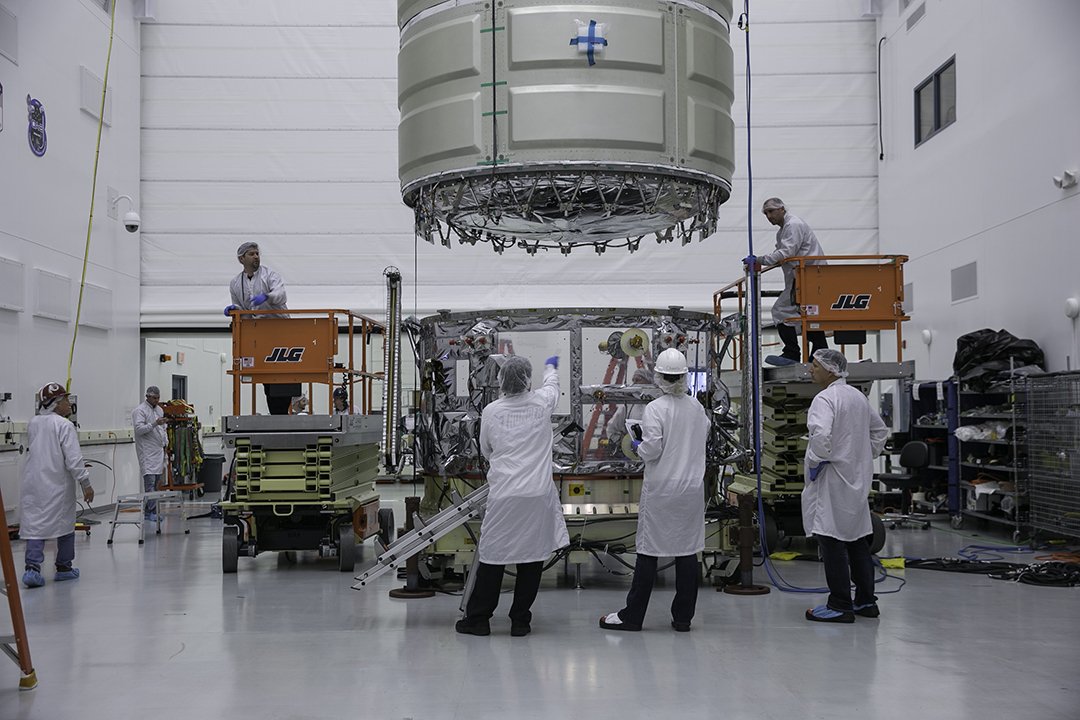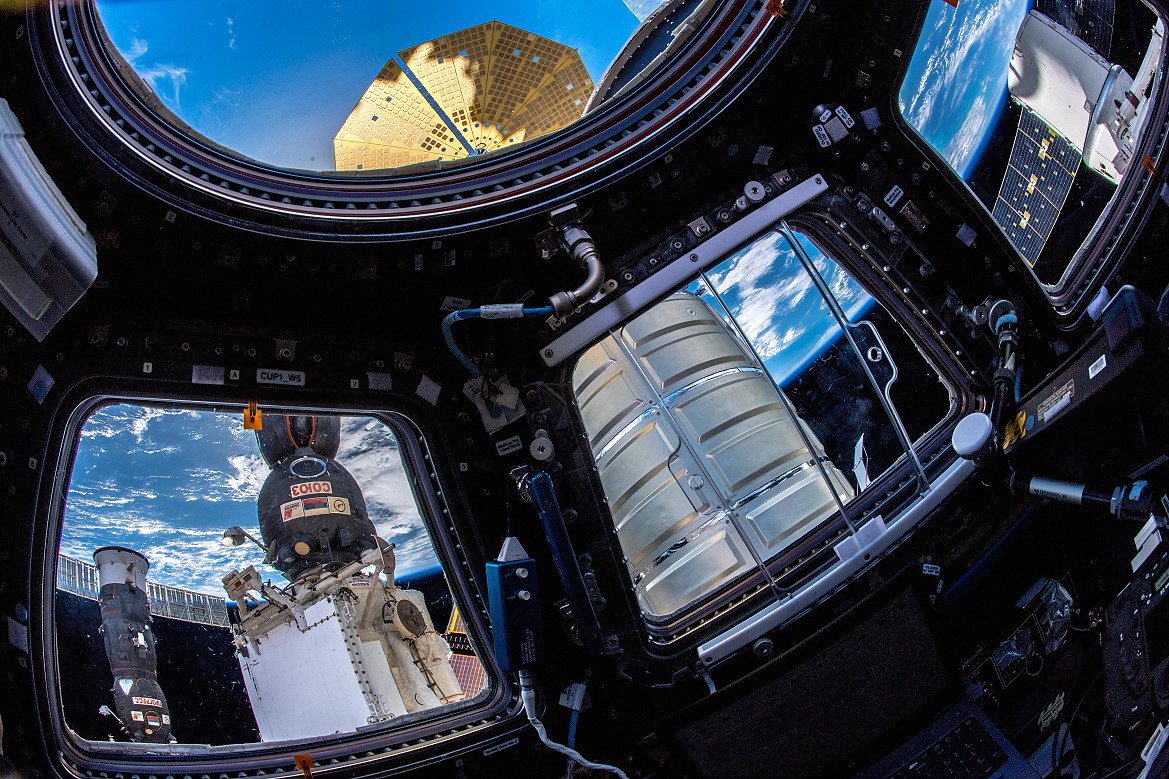14.08.2020
Next Cygnus Supply Mission Targets 29 Sept Launch to Space Station

NASA and Northrop Grumman Corp. are targeting Tuesday, 29 September for the next uncrewed visitor to the International Space Station (ISS), as the NG-14 Cygnus cargo ship—as-yet-unnamed, but expected to be given the name of someone who has played a role in human space exploration—makes the uphill trek from Pad 0A at the Mid-Atlantic Regional Spaceport (MARS) on Wallops Island, Va., to the sprawling multi-national orbiting outpost, with a full load of experiments, payloads and supplies. And if the mission does indeed take flight on its alloted date, it will occur on the seventh anniversary of the very first Cygnus visit to the ISS.

“Preparations are underway at @NASA_Wallops for the NG-14 #Cygnus spacecraft launch aboard our #Antares rocket,” noted prime contractor Northrop Grumman in a Monday tweet. “Targeted for Sept 29.”
Assuming an on-time launch atop Northrop Grumman’s 133-foot-tall (40.5-meter) Antares 230+ booster, it can be expected that Cygnus will arrive in the vicinity of the space station approximately two days later. It will be robotically captured by the 57.7-foot-long (17.6-meter) Canadarm2 robotic arm and berthed at the Earth-facing (or “nadir”) port of the Unity node. And if Crew-1—the first “operational” Crew Dragon mission—launches as planned in late September, NG-14 may be received by a long-duration crew of seven for the first time in ISS Program history. Cygnus will remain berthed at the station for around a month, before a scheduled departure and destructive re-entry in November.

It has been a long and tumultuous seven years since the first Cygnus, designated “ORB-D”, a “demonstration” mission flown by Orbital Sciences Corp., launched on 18 September 2013 and following several delays en-routewas robotically berthed at the ISS eleven days later. The spacecraft was selected as one of two commercial providers for NASA under the first phase of the Commercial Resupply Services (CRS) contract, signed back in December 2008, whose provisions initially required eight Cygnus missions. Under the terms of the contract, Orbital would launch upwards of 44,000 pounds (20,000 kg) of payloads and supplies to successive ISS crews through 2016.

It was intended that Cygnus would fly atop Orbital’s home-grown Antares booster from the MARS site, but due to technical issues with the development of the rocket and issues pertaining to cryogenic tankage, ORB-D suffered significant delay. Following ORB-D, a pair of dedicated missions (ORB-1 and ORB-2) took place successfully in January and July 2014, followed by the catastrophic loss of ORB-3 the following October.
Captured in an array of spectacular imagery by AmericaSpace’s photography team, the Antares carrying the ORB-3 Cygnus was lost a few seconds after liftoff, in an accident later blamed upon a liquid oxygen turbopump failure. The next two cargo missions—designated “OA-4” and “OA-6”, after Orbital Sciences’ merger with Alliant TechSystems to become Orbital ATK, Inc.—rode atop United Launch Alliance (ULA) Atlas V boosters in December 2015 and March 2016, whose increased uplift capability and a transition from the “standard” Cygnus to the larger payload envelope of an “enhanced” variant allowed the initial CRS payload mass requirement of 44,000 pounds (20,000 kg) to be surpassed.

Unlike the standard Cygnus, the enhanced configuration, used on ten missions between December 2015 and February 2020, benefits from a larger Pressurized Cargo Module (PCM) and can deliver a 60-percent-greater haul of payloads and supplies compared to its predecessor. Combined with its attached Service Module (SM), the enhanced Cygnus stands 15.9 feet (4.86 meters) tall, about 3.9 feet (1.2 meters) higher than the standard version, although their respective diameters are the same at 10.1 feet (3.07 meters).


Northrop Grumman has announced that its next Cygnus capsule will be named the "S.S. Kalpana Chawla," in memory of the mission specialist who died with her six crewmates aboard the space shuttle Columbia in 2003.
The S.S. Kalpana Chawla is scheduled to launch on the NG-14 mission atop a Northrop Grumman Antares rocket from the Mid-Atlantic Regional Spaceport (MARS) at NASA's Wallops Flight Facility in Virginia on Sept. 29 at 10:26 p.m. EDT (0226 GMT Sept. 30). The spacecraft will arrive at and be attached to the space station two days later.
"It is the company's tradition to name each Cygnus after an individual who has played a pivotal role in human spaceflight," Northrop Grumman said in a statementreleased on Tuesday (Sept. 8). "Chawla was selected in honor of her prominent place in history as the first woman of Indian descent to go to space."
Born in Haryana, India, Chawla moved to the United States to earn her master's and doctorate degrees in aerospace engineering from the University of Texas in 1984 and University of Colorado in 1988, respectively. She then began her career at NASA, conducting research in fluid dynamics at the Ames Research Center in California.
After becoming a naturalized U.S. citizen, Chawla applied for and became a NASA astronaut as a member of "The Flying Escargot," NASA's 15th class of trainees. In 1997, she launched on STS-87, a 15-day shuttle mission that was dedicated to the science flying as part of the fourth United States Microgravity Payload (USMP-4).
Chawla's second spaceflight, STS-107, came to a tragic end on Feb. 1, 2003, following 16 days of conducting science on board the space shuttle Columbia. A small piece of foam that struck the orbiter's left wing during launch created a hole that went undetected during the mission. Upon Columbia's return to Earth, hot plasma entered the wing, tearing it apart, and the resulting loss of control led to the vehicle disintegrating and the death of the crew.
"While Chawla made the ultimate sacrifice in service to the space program, her legacy lives on through her fellow astronauts and those she has inspired to follow in her footsteps," Northrop Grumman stated. "Her final research conducted on board Columbia helped us understand astronaut health and safety during spaceflight. Northrop Grumman is proud to celebrate the life of Kalpana Chawla and her dream of flying through the air and in space."
On the NG-14 mission, the S.S. Kalpana Chawla will deliver approximately 8,000 pounds (3,630 kilograms) of cargo to the station. Research flying aboard the Cygnus includes the test of a biologic drug that could be used for the treatment of leukemia, a plant growth study that will cultivate radishes as a model for future crops in space, a compact toilet for astronauts to use on deep-space exploration missions and a 360-degree virtual reality camera that will be used to film during a spacewalk for an immersive cinematic production.
The S.S. Kalpana Chawla is the second Cygnus to be named for a member of the STS-107 crew. Columbia's last commander, Rick Husband, was similarly honoredin 2016.
Other astronaut namesakes have been David Low, Gordon Fullerton, Janice Voss, Deke Slayton, Alan Poindexter, John Glenn, Gene Cernan, John Young, Roger Chaffee and Alan Bean. The most recent Cygnus, which launched in February and departed the space station in May, was named the S.S. Robert Lawrence after the first African American to be selected as an astronaut.
An additional Cygnus was named the S.S. J.R. Thompson after a former company executive.


NG-14 Cygnus Readies for Tuesday Night Launch From Wallops

It seems entirely fitting that a mission destined to ferry science cargo to the International Space Station (ISS) should be named for a deceased NASA astronaut who participated in the final dedicated science mission of the Space Shuttle Program. The name of veteran astronaut Kalpana “K.C.” Chawla—the first woman of Indian ancestry to voyage into space and a member of shuttle Columbia’s ill-fated STS-107 crew—was announced earlier this month and will be borne by Northrop Grumman Corp.’s NG-14 Cygnus cargo ship.
Launch atop an Antares 230+ booster is targeted for 10:26 p.m. EDT on Tuesday, 29 September from Pad 0A at the Mid-Atlantic Regional Spaceport (MARS) on Wallops Island, Va. It will arrive at the station on Saturday, 3 October, and is expected to spend two months there, before departing in mid-December and deorbiting at year’s end.
With only a few days remaining before “Space Ship Kalpana Chawla” takes flight, NASA hosted a media teleconference on Thursday afternoon (24 September) to outline the wide range of scientific investigations heading to the station. The Initial Cargo Load aboard Cygnus was completed last week, with Late Load operations wrapped up on Tuesday. There will be a final cargo load of time-critical experiments on Monday at Pad 0A, when Antares will be lowered to the horizontal configuration and a “pop-top” will afford technicians access to the spacecraft.
We completed the initial cargo load on September 16 and just completed late load on September 22. Cygnus is now undergoing fairing encapsulation in preparation for Antares to be rolled to the pad. Approximately 24 hours below launch we will do our final cargo load at the pad with the rocket horizontal.
As previously detailed by AmericaSpace, the launch will occur on the seventh anniversary of the first Cygnus arrival at the ISS and will be laden with a whopping 7,758 pounds (3,519 kg) of equipment, payloads and supplies to the station for the incumbent Expedition 63 and forthcoming Expedition 64 crews. This total includes 2,683 pounds (1,217 kg) of science investigations, 1,874 pounds (850 kg) of crew supplies, 2,712 pounds (1,230 kg) of vehicle hardware, 333 pounds (151 kg) of Extravehicular Activity (EVA) equipment and 156 pounds (71 kg) of computer resources.
Assuming an on-time launch, NG-14 will spend three days in transit, before it is robotically captured and berthed at the Earth-facing (or “nadir”) port of the station’s Unity node early on Saturday, 3 October. The capture will be led by Expedition 63 Commander Chris Cassidy, using the 57.7-foot-long (17.6-meter) Canadarm2 robotic arm, and will kick off more than two months of joint operations with the Cygnus. Cassidy will be backed-up in the station’s multi-windowed cupola by crewmate Ivan Vagner. Berthing of the spacecraft at Unity will be ground-commanded.
Current plans call for the spacecraft to be robotically unberthed on 16 December, after which it will spend two weeks in free flight, autonomously conducting the fifth set of Spacecraft Fire Experiments (SAFFIRE-V). Cygnus will then undertake a destructive re-entry into the atmosphere on 30 December, wrapping up its 92-day mission.
Provided by NASA’s Glenn Research Center (GRC) in Cleveland, Ohio, SAFFIRE seeks to safely examine the processes of combustion, smoke behavior and flame-spreading in the microgravity environment. Understanding fire behavior in space and how different materials propagate flames in the near-total absence of gravity carries profound implications for the development of future spacecraft.
Four previous SAFFIRE runs between July 2016 and May 2020 burned Solid Inflammatory Boundary at Low Speed (SIBAL) cloth—a cotton blend on a fiberglass substrate—as well as specimens of Plexiglas and Nomex.
SAFFIRE-V and the final member of the series, SAFFIRE-VI, which is currently targeted to launch aboard the NG-15 Cygnus next spring, will press the envelope by running their experiments at much lower pressures of about 8.2 psi and a 34-percent oxygen level, which is expected to increase the energetic vigor of the observed flames.
Another post-departure experiment aboard NG-14 is Northrop Grumman’s 71-pound (32 kg) SharkSat payload, a technology prototype to permit engineers to evaluate emerging technologies in the space environment. “SharkSat is a small payload that will mount to the Cygnus spacecraft, with a mission to collect telemetry data demonstrating the feasibility of new sensor and processing technologies in low Earth orbit,” Northrop Grumman’s Vicki Cox told AmericaSpace.
“Development timelines and lifecycles for space electronics are shrinking as missions are more rapidly evolving,” she continued. “This was an opportunity to bring in some innovation to our traditional processes and “experiment” with how we can quickly leverage robust commercial technology base, to meet these new mission timelines. SharkSat was a success in this regard demonstrating our capability and identifying future process alterations to further improve schedules.”
SharkSat will remain attached to Cygnus as a “hosted” payload. “It will not be powered on until Cygnus departs the ISS in mid-December and will operate for about two weeks,” Ms. Cox added. “We expect to collect telemetry data and performance information hopefully confirming performance on-orbit.”
Elsewhere aboard NG-14’s Pressurized Cargo Module (PCM) will be a multitude of science and technology experiments. The Plant Habitat-2 investigation, led by Dr. Karl Hasenstein of the University of Louisiana at Lafayette and provided by Techshot, Inc., of Exploration Park, Fla., will utilize the station’s Advanced Plant Habitat (APH) to cultivate radishes.
Over a 27-day growth cycle, the radishes’ metabolic and physiological behavior will be examined, as will their response to the space environment, as part of ongoing NASA efforts to sustain future astronauts on deep-space missions. Harvested radish specimens will be stored in the station’s Minus Eighty Degree Laboratory Freezer for ISS (MELFI).
A new station toilet, destined for installation in the Tranquility node and expected to be used on deep-space and lunar missions, will also ride into orbit aboard NG-14. The Universal Waste Management System (UWMS) will feed pre-treated urine into a regenerative system, which will recycle it into water for future use. At present, about 90 percent of all water-based liquids on the space station (including urine and sweat) are recycled, mimicking elements of Earth’s own water cycle to reclaim water from the air.

Sixty-five percent smaller and 40 percent lighter than the current ISS toilet, the UWMS features an automatic airflow start-up when the lid is raised, which is also expected to enhance odor control, and its ergonomic design should require less cleaning, maintenance and plumbing. Earlier this week, Chris Cassidy installed a cable for the UWMS.
Provided by Dr. Carlos Cabrera of the University of Puerto Rico, the Ammonia Electro-Oxidation Lab at the ISS (AELISS) experiment seeks to describe the electrochemical oxidation of ammonia in the microgravity environment, as part of efforts to advance long-term habitability aboard the space station through its water recovery capabilities. ALEISS also features collaboration from NASA’s Ames Research Center (ARC) in Moffett Field, Calif.
Elsewhere, Estée Lauder plans to photograph the company’s New Advanced Night Repair serum in the cupola “as part of NASA’s efforts to enable business activities at the space station”.
Other payloads include the ISS Experience EVA Camera to film a future spacewalk and Earth views in cinematic-quality, 360-degree virtual reality. According to NASA’s Dan Huot, a specific EVA has yet to be determined, with no spacewalks expected until after the arrival of Crew-1 astronauts Mike Hopkins, Victor Glover, Shannon Walker and Soichi Noguchi in late October. “It’s designed to be mounted on Canadarm2,” Mr. Huot told AmericaSpace. “Still waiting on what the final procedures will look like.” It may be carried outside by the astronauts and mounted in place or passed through the airlock of Japan’s Kibo lab.
Quelle: AS
----
Update: 2.10.2020
.
Scrub Week Continues, Antares Launch Now NET Friday Night


Northrop Grumman Corp. is now aiming for 9:16 p.m. EDT tonight to launch its NG-14 Cygnus cargo ship to the International Space Station (ISS), following a scrub in the final minutes of Thursday evening’s countdown. Mounted atop a giant Antares 230+ booster on Pad 0A at the Mid-Atlantic Regional Spaceport (MARS) on Wallops Island, Va., the mission experienced a relatively benign countdown, despite a wayward boat in the launch danger area and an intermittent telemetry issue, before it was eventually called off in response to “an unknown problem” with a Ground Support Equipment (GSE) component.
Quelle: AS
----
Update: 3.10.2020
.
Erfolgreicher Start von Cygnus NG-14 spacecraft
























Quelle: NASA
